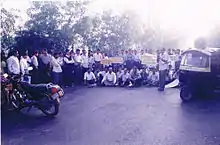Traffic obstruction
Traffic obstruction is a common tactic used during public protests and demonstrations.[1][2] The transport users affected by such disruptions are often unsympathetic to the cause.[3][4][5][6]
Legality
Most jurisdictions consider the obstruction of traffic an illegal activity and have developed rules to prosecute those who block, obstruct, impede, or otherwise interfere with the normal flow of vehicular or pedestrian traffic upon a public street or highway.[7] Some jurisdictions also penalize slow moving vehicle traffic. The unimpeded flow of traffic in the public road-space is often considered a common right.
Examples
Examples of intentional traffic obstructions aimed to articulate a protest agenda include Extinction Rebellion protests,[8] air traffic controller strike, highway revolts, Critical Mass bicycle rides corking intersections, obstruction of rail transport of nuclear fuel in Germany, road blockades by farmers or truckers in France and other countries, impact on Eurotunnel operations by the Migrant Crisis around Calais, pipeline protests (e.g. Dakota Access Pipeline), etc.
Raasta roko
Raasta roko (Hindi: "obstruct the road") is a form of protest commonly practised in India.[9] It usually involves large numbers of people preventing vehicular traffic from using a busy thoroughfare. Pedestrian traffic is not targeted.
Rail roko is similar blocking of a railway.[10]
See also
References
- Badger, Emily (13 July 2016). "Why highways have become the center of civil rights protest". The Washington post. Retrieved 7 September 2017.
- Yongshun, Cai (2010). Collective Resistance in China: Why Popular Protests Succeed Or Fail. Stanford University Press. p. 110-111. ISBN 978-0804763394.
- "Proposed laws would crack down on protesters who block roadways". CNN. 26 January 2017. Retrieved 7 September 2017.
- "Stopping traffic: Minnesota lawmakers try increase penalties for common protest tactic". Salon. Retrieved 7 September 2017.
- "In Protests, Who Owns the Highways?". citylab. Retrieved 7 September 2017.
- Chen, Xi (2011). Social Protest and Contentious Authoritarianism in China. Cambridge University Press. p. 176.
- https://timesofindia.indiatimes.com/india/protesters-cant-block-roads-or-public-spaces-rules-sc/articleshow/78544230.cms
- Emilie Ruscoe; Esha Ray (23 June 2019). "70 people arrested protesting climate change outside New York Times hq in Midtown". New York Daily News.
- K. Bhushan; G. Katyal (1 January 2003). Attack on Akshardham: temple terror. A.P.H. Pub. Corp. ISBN 978-81-7648-446-6. Retrieved 28 September 2012.
- Immanuel Ness; Dario Azzellini (5 July 2011). Ours to Master and to Own: Workers' Control from the Commune to the Present. Haymarket Books. pp. 360–. ISBN 978-1-60846-119-6. Retrieved 28 September 2012.
